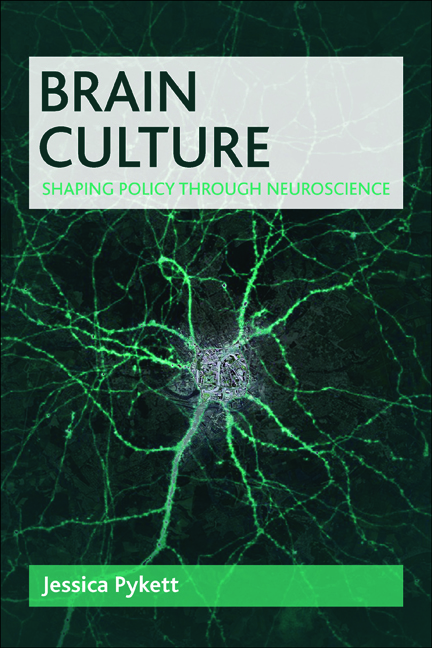Book contents
- Frontmatter
- Dedication
- Contents
- About the author
- Acknowledgements
- Preface
- One Introduction: governing through brain culture
- two Brain culture in context
- three Designing cerebral cities
- four Teaching the learning brain
- five Managing workplace emotions
- six Conclusion: what is at stake in the brain world?
- References
- Index
four - Teaching the learning brain
Published online by Cambridge University Press: 10 March 2022
- Frontmatter
- Dedication
- Contents
- About the author
- Acknowledgements
- Preface
- One Introduction: governing through brain culture
- two Brain culture in context
- three Designing cerebral cities
- four Teaching the learning brain
- five Managing workplace emotions
- six Conclusion: what is at stake in the brain world?
- References
- Index
Summary
The way in which brains operate is fully determined by the integrative properties of the individual nerve cells and the way in which they are connected. It is the functional architecture, the blueprint of connections and their respective weight, that determines how brains perceive, decide and act. Hence, not only all the rules according to which brains process information but also all the knowledge that the brain possesses reside in its functional architecture. It follows from this that the connectivity patterns of brains contain information and that any learning, ie the modification of computational programs and of stored knowledge, must occur through lasting changes of their functional architecture. (Singer, 2008, p 98, emphasis added)
You hold in your hands a historical publication. This book is the first to bring together some of the most influential scholars responsible for giving birth to a new body of knowledge: educational neuroscience.[…] And teaching will never be the same again. (Sousa, 2010, p 1, original emphasis)
Introduction
‘Neuroeducation’, including in its various guises, the research endeavour of educational neuroscience and more applied approaches to brain-based or brain-compatible teaching and learning, seems to signify a more developed and defined field than neuroarchitecture. Somewhat confusingly in light of the previous chapter, it is the neuroarchitecture or functional architecture of the brain (the organisational networks and connections of the brain) that preoccupy neuroeducationalists. There is often a tendency in this work to understand this functional architecture in explicitly determinist terms, and to reduce learning to an algorithmic or computational process, as in the account offered by renowned neuroscientist Wolf Singer (2008) in the above quote. Neuroeducation has been promoted since the 1990s through learned institutions, academic publications, corporate organisations and consultancies, and promises to revolutionise the world of teaching and learning, often in the hyperbolic manner offered above by Sousa. Broadly speaking, neuroeducation aims to use neuroscience, biology and cognitive science to better understand how people learn (usually focusing on children in formal educational settings).
There has been a concerted effort to separate out evidence-based pedagogic techniques and so-called ‘neuromyths’, and to elaborate the grounds for cultivating two-way dialogue between neuroscientists and educators (Blakemore and Frith, 2005; Goswami, 2006; Howard-Jones, 2007; The Royal Society, 2011b).
- Type
- Chapter
- Information
- Brain CultureShaping Policy through Neuroscience, pp. 97 - 138Publisher: Bristol University PressPrint publication year: 2015



